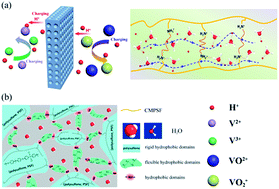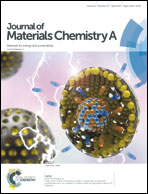Advanced charged porous membranes with flexible internal crosslinking structures for vanadium flow batteries†
Abstract
Advanced charged porous membranes with flexible internal crosslinking networks were designed and fabricated for vanadium flow battery application. Flexible 1,4-diaminobutane was introduced in CMPSF spongy porous membranes to build flexible crosslinking networks on the pore walls. The flexible segments could induce relatively highly micro-phase separated structures (hydrophilic and hydrophobic phase) and effectively enhance the mobility of hydrophilic and hydrophobic domains, which is highly beneficial for proton transportation. At the same time, the positively charged crosslinking networks can ensure the high chemical stability of resulting membranes. As a result, porous membranes with flexible crosslinking networks could meet the requirement of VFB application owing to their excellent conductivity, high selectivity and high chemical stability. A VFB single cell with the prepared charged porous membrane exhibits a coulombic efficiency (CE) of more than 99% and an energy efficiency (EE) of about 87% at 80 mA cm−2, showing much higher performance than commercial Nafion 115 (CE = 92.5%, EE = 83.7%). A VFB employing the prepared membrane maintains a stable performance after more than 4000 charge–discharge cycles, showing impressive potential for VFB application.



 Please wait while we load your content...
Please wait while we load your content...